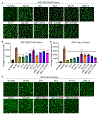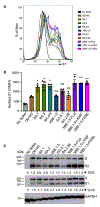Immune evasion, infectivity, and fusogenicity of SARS-CoV-2 BA.2.86 and FLip variants
- PMID: 38194968
- PMCID: PMC10872432
- DOI: 10.1016/j.cell.2023.12.026
Immune evasion, infectivity, and fusogenicity of SARS-CoV-2 BA.2.86 and FLip variants
Abstract
Evolution of SARS-CoV-2 requires the reassessment of current vaccine measures. Here, we characterized BA.2.86 and XBB-derived variant FLip by investigating their neutralization alongside D614G, BA.1, BA.2, BA.4/5, XBB.1.5, and EG.5.1 by sera from 3-dose-vaccinated and bivalent-vaccinated healthcare workers, XBB.1.5-wave-infected first responders, and monoclonal antibody (mAb) S309. We assessed the biology of the variant spikes by measuring viral infectivity and membrane fusogenicity. BA.2.86 is less immune evasive compared to FLip and other XBB variants, consistent with antigenic distances. Importantly, distinct from XBB variants, mAb S309 was unable to neutralize BA.2.86, likely due to a D339H mutation based on modeling. BA.2.86 had relatively high fusogenicity and infectivity in CaLu-3 cells but low fusion and infectivity in 293T-ACE2 cells compared to some XBB variants, suggesting a potentially different conformational stability of BA.2.86 spike. Overall, our study underscores the importance of SARS-CoV-2 variant surveillance and the need for updated COVID-19 vaccines.
Keywords: BA.2.86; FLip; Omicron; XBB.1.5; fusogenicity; infectivity; mAb S309; neutralization.
Copyright © 2023 The Author(s). Published by Elsevier Inc. All rights reserved.
Conflict of interest statement
Declaration of interests The authors do not declare any competing interests.
Figures






Update of
-
Immune Evasion, Infectivity, and Fusogenicity of SARS-CoV-2 Omicron BA.2.86 and FLip Variants.bioRxiv [Preprint]. 2023 Sep 12:2023.09.11.557206. doi: 10.1101/2023.09.11.557206. bioRxiv. 2023. Update in: Cell. 2024 Feb 1;187(3):585-595.e6. doi: 10.1016/j.cell.2023.12.026. PMID: 37745517 Free PMC article. Updated. Preprint.
References
-
- Gangavarapu K, Latif AA, Mullen JL, Alkuzweny M, Hufbauer E, Tsueng G, Haag E, Zeller M, Aceves CM, Zaiets K, et al. (2023). Outbreak.info genomic reports: Scalable and dynamic surveillance of SARS-CoV-2 variants and mutations. Nat Methods 20, 512–522. - PMC - PubMed
-
- Yuan S, Ye Z-W, Liang R, Tang K, Zhang AJ, Lu G, Ong CP, Man Poon VK, Chan CC-S, Mok BW-Y, et al. (2022). Pathogenicity, transmissibility, and fitness of SARS-CoV-2 Omicron in Syrian hamsters. Science 377, 428–433. - PubMed
-
- Shuai H, Chan JFW, Hu B, Chai Y, Yuen TTT, Yin F, Huang X, Yoon C, Hu JC, Liu H, et al. (2022). Attenuated replication and pathogenicity of SARS-CoV-2 B.1.1.529 Omicron. Nature 603, 693–699. - PubMed
-
- Zeng C, Evans JP, Qu P, Faraone J, Zheng YM, Carlin C, Bednash JS, Zhou T, Lozanski G, Mallampalli R, et al. (2021). Neutralization and stability of SARS-CoV-2 Omicron variant. Preprint at bioRxiv, 2021.12.16.472934.
Publication types
MeSH terms
Substances
Supplementary concepts
Grants and funding
LinkOut - more resources
Full Text Sources
Medical
Miscellaneous

